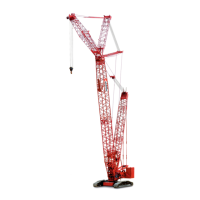MAINTENANCE CHECKLIST OPERATOR MANUAL 600E2
6-4 PUBLISHED 04-26-2019 CONTROL # 113-09
• Core failure in rotation resistant ropes.
• Prior electrical contact with a power line or other electric
arc damage.
• A broken strand.
• Significantly corroded, cracked, bent, or worn end
connections.
Only inspect the outer surface of a cable. Never attempt to
open the cable.
Pay particular attention to areas of the rope where wear and
other damage is likely to occur:
• Pick-up Points: Sections of wire rope that are repeatedly
stressed during each lift, such as those sections in
contact with sheaves.
• End Attachments: The point where a fitting is attached to
the wire rope or the point where the wire rope is attached
to the hoist drum.
• Abuse Points: The point where the wire rope is
subjected to abnormal scuffing and scraping.
Daily Inspections
All cable in continuous service must be inspected at the
beginning of each work day. Inspect the eye end and length
of cable that is used in daily operation. The end should be
inspected for abrasion, corrosion, broken wires, and loose or
broken servings. Inspect the remainder of the cable length
used for daily operations for points showing kinks, sharp
bends, or any other evidences of damage or excessive wear.
Monthly Inspections
Inspect the eye end and length of cable normally used in
daily operations. Examine the rest of the cable for kinked,
crushed or otherwise damaged points.
Periodic Inspections
Wire rope should be inspected periodically/annually, or at a
shorter time interval, if necessitated by environmental or
other adverse conditions, and shall cover the entire length of
the wire rope. Periodic inspection should include all previous
items listed under Inspection, plus the following:
• Inspect for severely corroded or broken wires at end
connections.
• Inspect wire rope in areas subjected to rapid
deterioration such as:
- Sections in contact with saddles, equalizer sheaves,
or other sheaves where wire rope travel is limited.
- Sections of wire rope at or near terminal ends where
corroded or broken wires may protrude.
• Inspect boom nose sheaves, hook block sheaves, boom
extension/extension sheaves, auxiliary boom nose
sheaves, and hoist drums for wear. Damaged sheaves
or hoist drums can accelerate wear and cause rapid
deterioration of the wire rope.
Inspect the eye end of the cable for greater wear than the
rest of the cable. If the cable is in good condition, reverse the
cable on the drum so that the wear is equalized along the
total length of the cable.
Wire Rope Replacement
No precise rules can be given for determination of the exact
time for replacement of wire rope since many variable factors
are involved. Determination regarding continued use or
replacement of wire rope depends largely upon the good
judgment of an appointed and qualified person who
evaluates the remaining strength in a used rope after
allowance for any deterioration disclosed by inspection.
Wire rope replacement should be determined by the
following information excerpted from a National Consensus
Standard as referenced by Federal Government Agencies
and as recommended by National Crane. All wire rope will
eventually deteriorate to a point where it is no longer usable.
Wire rope shall be taken out of service when any of the
following conditions exist:
• Kinking, crushing, bird caging, or any other damage
resulting in distortion of the rope structure.
• Evidence of any heat damage from any cause.
• Reductions from nominal diameter of more than 5%.
• In running ropes, six randomly distributed broken wires
in one lay or three broken wires in one strand in one lay.
• In standing ropes, more than two broken wires in one lay
in sections beyond end connections or more than one
broken wire at an end connection.
• In rotation resistant rope, two randomly distributed
broken wires in six rope diameters or four randomly
distributed broken wires in 30 rope diameters.
• Severe corrosion as evidenced by pitting.
• National Crane recommends that for cable extended
booms, a single damaged wire rope assembly shall
require replacement of the entire set of extension
cables.
• National Crane recommends for cable extended booms,
that boom extension cables be replaced every seven (7)
years.
Care of Wire Rope
Handle wire rope with care to prevent damage to the
individual wires which affect the overall strength and
performance of the rope. Do not allow the formation of kinks,
because this displaces the strands of wire from their original
position and relation to each other causing severe bending
Fo
r
Reference
Only

